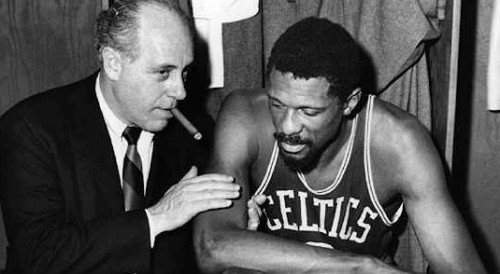
Red and Me (2009)
Rating: 4/10
A short, gentle look by Bill Russell at his relationship with legendary Celtics coach and GM Red Auerbach, “Red and Me” is a light read with a few interesting anecdotes, a real sense of what Red meant to Russell but is something less than the whole of its parts.
“Red and Me” is less a memoir of his time with Red, or even the Celtics, as it is a book explicitly about their friendship. It sometimes feels like an instruction manual for how to be a good friend. Whenever Russell tells an anecdote about his time with Red, it’s almost always to illustrate a point about how friendships between men are fostered: trust, communication, no bullshit, etc. It’s a little clinical, but you can tell Russell’s thought about their relationship a lot and what made it work.
There were a few factors at work here. There were personal elements, like how they both respected each other’s privacy. There was the practical: they sought each other’s input on big decisions. Mostly, it was a mutual sense of respect. Not only did they know each other well, but they knew how to approach touchy subjects and make it seem like it came up naturally. It’s little details like this that explain how and why these Celtic teams were so successful; they once won eight consecutive championships.
Sometimes, Russell looks back on how Red compared to his other coaches (not favorably) and what made Red so successful in the NBA. Mostly, it was a really hands-off coaching style, letting them mostly coach themselves and keep egos in check (real shades of Ken Dryden’s “The Game” here). The Celtics of the 1960s were a highly talented team. They didn’t need strategy sessions to figure out what to do, especially with strong personalities like Russell and Auerbach running the show.
One example: the Celtics had just six plays under Auerbach. Most of what they did during games was based off past experiences. An example: Russell would grab a defensive rebound and already knew where Bob Cousy would be standing, so he could throw a quick pass without looking and start a fast break. This didn’t come from Red, but from a team who knew itself, with Cousy suggesting it during a practice and it was quickly adopted. This couldn’t have happened under a coach who imposed his system on his team.
There are other examples of what made this team tick. Red had full run of the team under Celtics owner Walter Brown. When there were issues from fans and the press over the racial makeup of the Celtics – and as Russell illustrates, there always were among segments of the Boston crowd – Red was supported by Brown and the other owners. Another example: although he had sources all over the country for basketball knowledge, Russell explains he made his own choices: he gave KC Jones a shot after scouts told him Jones couldn’t play. Jones became a key part of eight Celtic championship teams.
All in all, the book is somewhat successful. You don’t learn much about Red or Russell as individuals, let alone the teams they were both a part of, but you get an idea of why their relationship worked. Players like Jones, Cousy or Tommy Heinsohn show up occasionally, I didn’t really get a sense of what how they fit into the team.
However fleeting, this is an occasionally nice look into some of the NBA’s most successful teams. You won’t know any of the other players any better, but you’ll get a sense of Red Auerbach the coach and how he was the only person who could’ve run this team. That’s probably the point: Russell was writing a book about him and Red. Without one or the other, these Celtics teams wouldn’t have been anywhere near as successful.
Recommended for hardcore NBA junkies and Celtic fans, but not over Russell’s earlier, more successful memoir “Second Wind” or John Feinstein’s book of Red Auerbach tales “Let Me Tell You a Story: A Lifetime in the Game”. People interested in coaching might enjoy a read, too: there’s some good advice to be gleaned from Russell’s memories of Auerbach’s coaching style.
[php snippet=1]

